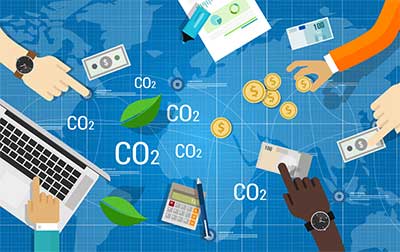Date : 03/06/2023
Relevance : GS Paper 3: Climate change,Sustainable Economy
Key Words : Emissions Trading System (ETS), greenhouse gas emissions,carbon leakage, WTO law.
Context-
- The European Union's Carbon Border Adjustment Mechanism (CBAM) has raised concerns in India regarding the potential impact on its carbon-intensive exports to the EU.
- India has criticized CBAM as protectionist and discriminatory, prompting discussions about challenging it at the World Trade Organization (WTO).
Understanding CBAM:
- The EU's Emissions Trading System (ETS), established in 2005, is a market-based mechanism aimed at reducing greenhouse gas emissions. However, the EU is worried that imports from countries with less stringent environmental policies may not face equivalent carbon pricing, placing its industries at a disadvantage.
- CBAM proposes levying the same costs on imports of carbon-intensive products as borne by EU producers under the ETS. The price would be linked to the emissions priced under the ETS, with potential reductions if carbon pricing has been explicitly paid in the country of origin.
WTO Consistency:
- Non-discrimination is a fundamental principle of WTO law. While CBAM appears to be origin-neutral, its application may inadvertently discriminate based on inadequate carbon pricing policies or onerous reporting requirements for importers.
- The question arises whether the products subject to CBAM are truly "like" products. For instance, steel produced through electric arc furnaces is less carbon-intensive than that produced in blast furnaces. If the products are not deemed "like," traditional rules of non-discrimination may have limited application. This rekindles the longstanding debate on whether processes and production methods should be considered when comparing products.
Implications for India-EU Free Trade Agreement:
- CBAM has become a significant topic of discussion in the ongoing India-EU free trade agreement negotiations. It is crucial for India to collaborate with the EU to address CBAM concerns and ensure favorable conditions for Indian exporters. While the possibility of a WTO challenge remains open, India should strive for productive dialogue to maximize the benefits of a bilateral deal.
Implication for India
Impact India’s Export:
- It will have an adverse impact on India's exports of metals such as Iron, Steel and aluminum products to the EU, because these will face extra scrutiny under the mechanism.
Carbon Intensity and Higher Tariffs:
- The carbon intensity of Indian products is significantly higher than that of the EU and many other countries because coal dominates the overall energy consumption.
- The proportion of coal-fired power in India is close to 75%, which is much higher than the EU (15%) and the global average (36%).
- Therefore, direct and indirect emissions from iron and steel and aluminium are a major concern for India as higher emissions would translate to higher carbon tariffs to be paid to the EU.
Risk to Export Competitiveness:
- It will initially affect a few sectors but may expand to other sectors in the future, such as refined petroleum products, organic chemicals, pharma medicaments, and textiles, which are among the top 20 goods imported from India by the EU.
- Since India has no domestic carbon pricing scheme in place, this poses a greater risk to export competitiveness, as other countries with a carbon pricing system in place might have to pay less carbon tax or get exemptions
Conclusion:
The Carbon Border Adjustment Mechanism (CBAM) introduced by the EU raises complex issues at the intersection of international trade and the environment. Balancing environmental protection with non-discriminatory trade practices is crucial. Understanding the implications of CBAM and working towards mutually beneficial solutions should be a priority for all stakeholders involved.
Probable Questions for Main Examination:
- Question 1 : Analyze the concerns raised by India regarding the CBAM and its implications for trade protectionism and discrimination. How can these concerns be addressed within the framework of the World Trade Organization (WTO)? (10 Marks,150 Words)
- Question 2: In the context of CBAM, critically analyze the relationship between climate change goals and international trade. How can countries strike a balance between environmental sustainability and the principles of free and fair trade? (15 Marks, 250 Words)
Source : The Hindu






















